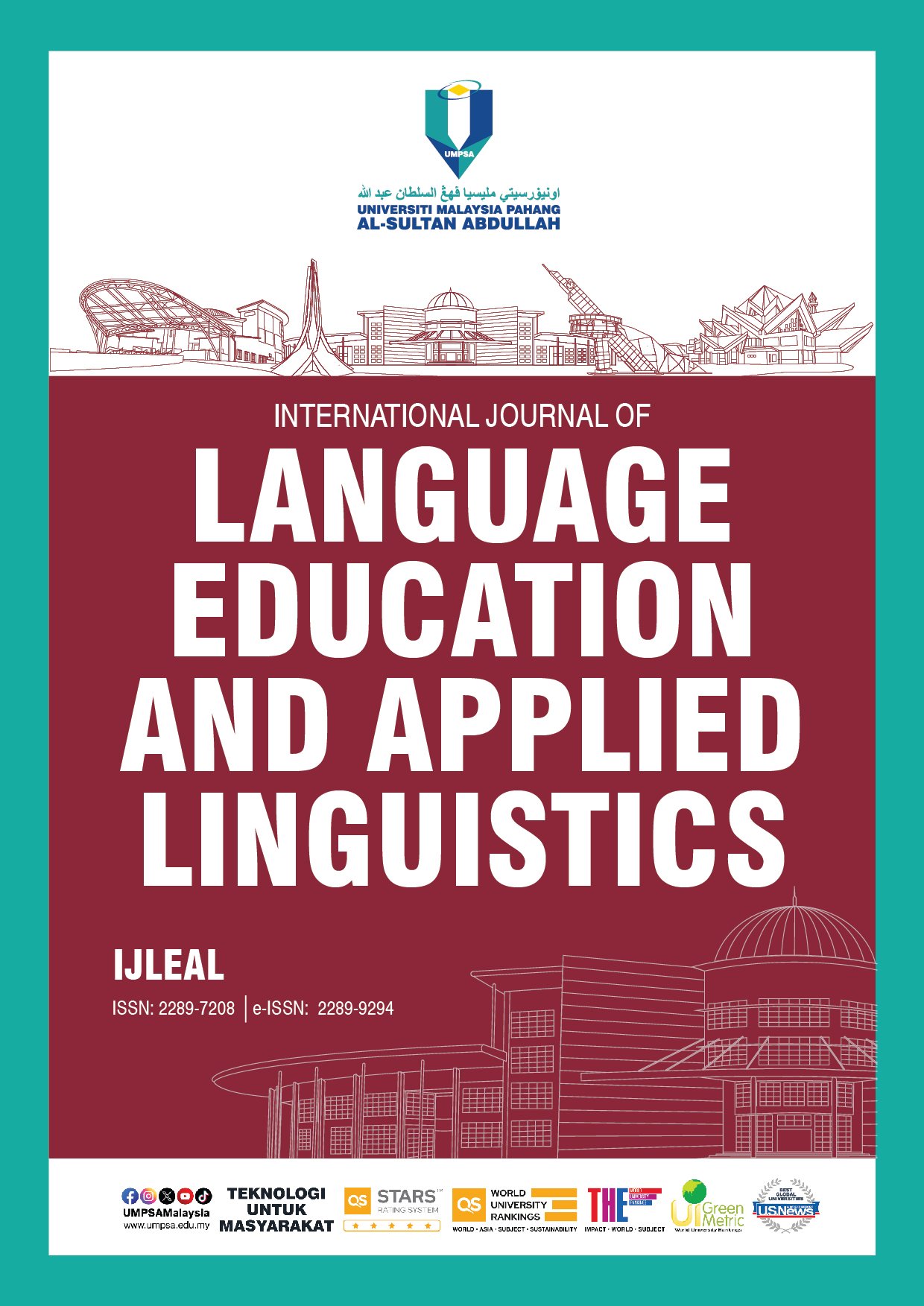Teacher Beliefs and Approaches to Vocabulary Teaching in Malaysian ESL Primary Classrooms
DOI:
https://doi.org/10.15282/Keywords:
Explicit vocabulary instruction , Incidental learning , Malaysian ESL classroom, Teacher beliefs, Vocabulary teachingAbstract
Vocabulary plays a key role in second language development, yet limited research has explored how Malaysian ESL primary teachers approach its instruction. This qualitative study investigates teachers’ beliefs about vocabulary teaching, the strategies they use, and the challenges they encounter. Semi-structured interviews were conducted with four ESL primary school teachers, and the data were analysed thematically. Findings reveal that teachers hold differing beliefs on explicit versus incidental instructions and using the mother tongue in vocabulary teaching. A range of strategies was identified, including direct teaching, peer learning, and encouraging independent vocabulary acquisition. However, challenges such as time constraints, low student motivation, and insufficient curricular emphasis on vocabulary were commonly reported. The study highlights the influence of teacher beliefs on instructional choices and the need for professional development to support effective vocabulary teaching. Future research using a mixed-methods approach is recommended to provide broader insights into vocabulary instruction practices in Malaysian primary ESL classrooms.
References
Alharbi, M. A. (2015). Building vocabulary for language learning: An approach for ESL learners to study new vocabulary. Journal of International Students, 5(4), 501–511. https://doi.org/10.32674/jis.v5i4.411
Ali, M. A. (2020). Investigation of vocabulary learning strategies to identify word meanings for Saudi EFL students in a reading context. Arab World English Journal, 11(3), 149–169. https://dx.doi.org/10.24093/awej/vol11no3.9
Azman, H. (2016). Implementation and challenges of English language education reform in Malaysian primary schools. 3L: The Southeast Asian Journal of English Language Studies, 22(3), 65–78. https://doi.org/10.17576/3L-2016-2203-05
Bailey, F., & Fahad, A. K. (2021). Krashen revisited: A case study of the role of input, motivation and identity in second language learning. Arab World English Journal, 12(2), 540–550. https://doi.org/10.24093/awej/vol12no2.36
Beck, I. L., McKeown, M. G., & Kucan, L. (2013). Bringing words to life: Robust vocabulary instruction (2nd ed.). Guilford Press.
Braun, V., & Clarke, V. (2006). Using thematic analysis in psychology. Qualitative Research in Psychology, 3(2), 77–101. https://doi.org/10.1191/1478088706qp063oa
Bryan Lim, W., Muhammad, M., Mihat, W., Syafiq Ya Shak, M., Rahman, M. A., & Prihantoro, P. (2023). Vocabulary index as a sustainable resource for teaching extended writing in the post-pandemic era. World Journal of English Language, 13(3), 181–198. https://doi.org/10.5430/wjel.v13n3p181
Bryman, A. (2016). Social research methods (5th ed.). Oxford University Press.
Chitravelu, N., Sithamparam, S., & Teh, S. C. (2022). ELT methodology: Principles and practice in Malaysia (4th ed.). Oxford Fajar.
Dang, T. N. Y., & Webb, S. (2020). The roles of explicit and incidental vocabulary learning strategies in L2 vocabulary acquisition. Studies in Second Language Learning and Teaching, 10(1), 149–175. https://doi.org/10.14746/ssllt.2020.10.1.7
Day, R. R., & Bamford, J. (2020). Extensive reading in the second language classroom. Cambridge University Press.
Dzulkiflee, M. M., & Said, N. (2023). ESL Teachers’ use of vocabulary digital content for vocabulary instruction. In M. Rahim, A. A. Ab Aziz, I. Saja @ Mearaj, N. A. Kamarudin, O. L. Chong, N. Zaini, A. Bidin, N. Mohamad Ayob, Z. Mohd Sulaiman, Y. S. Chan, & N. H. M. Saad (Eds.), Embracing change: Emancipating the landscape of research in linguistic, language and literature, vol 7. European Proceedings of Educational Sciences (pp. 130–137). European Publisher. https://doi.org/10.15405/epes.23097.12
Ellis, R. (2008). The study of second language acquisition (2nd ed.). Oxford University Press.
Etikan, I., Musa, S. A., & Alkassim, R. S. (2016). Comparison of convenience sampling and purposive sampling. American Journal of Theoretical and Applied Statistics, 5(1), 1–4. https://doi.org/10.11648/j.ajtas.20160501.11
Fainman, K., & Tokar, O. (2019). Blending explicit and implicit vocabulary instruction: New insights for ESL learners. TESOL Quarterly, 53(2), 400–420. https://doi.org/10.1002/tesq.490
Graves, M. F., & Sales, G. C. (2013). Teaching 50,000 words: Meeting and exceeding the Common Core State Standards for vocabulary. International Reading Association. https://doi.org/10.1598/e-ssentials.8035
Hassan, K. I., & Gao, X. (2021). Communicative language teaching in Malaysian ESL context: A qualitative exploration into in-service teachers’ beliefs and practices. International Journal of TESOL Studies, 3(1), 58–72. https://doi.org/10.46451/ijts.2021.01.05
Ishida, A., Manalo, E., & Sekiyama, T. (2024). Students’ motivation to learn English: The importance of external influence on the ideal L2 self. Frontiers in Education, 8, Article 1264624. https://doi.org/10.3389/feduc.2023.1264624
Kho, S. F. C. (2023). Students’ vocabulary learning strategies and teachers’ vocabulary teaching practices in Malaysian primary school English language classrooms [Master’s thesis, Universiti Malaysia Sarawak]. UNIMAS Institutional Repository. https://ir.unimas.my/id/eprint/41724/3/thesis%20master_SHRON%20KHO%20FUNG%20CHIEN.pdf
Kho, S. F. C., Ramanair, J., & Pandian, A. (2021). Students’ vocabulary learning strategies of discovery and consolidation in Malaysian primary school English language Classrooms. Pertanika Journal of Social Sciences & Humanities, 29(2), 1375–1395. https://doi.org/10.47836/pjssh.29.2.33
Laufer, B. (2017). The role of vocabulary in second language acquisition: Theoretical perspectives and practical implications. In S. Webb (Ed.), The Routledge Handbook of Vocabulary Studies (pp. 407–421). Routledge. https://doi.org/10.4324/9780429291586-27
Macaro, E. (2020). Exploring the role of the first language in second language learning. Multilingual Matters.
Marzban, A., & Kamalian, K. (2013). The effect of explicit vs. implicit vocabulary instruction on intermediate EFL learners’ vocabulary knowledge. ELT Voices, 3(6), 84–95. https://doi.org/10.24815/siele.v4i1.7001
Mazlan, N. H., Rahim, H. A., & Hashim, H. (2022). Integrating technology in vocabulary instruction: Challenges faced by Malaysian ESL teachers. Journal of Education and e-Learning Research, 9(2), 95–102.
Merriam, S. B., & Tisdell, E. J. (2016). Qualitative research: A guide to design and implementation (4th ed.). Jossey-Bass.
Milton, J. (2021). Measuring second language vocabulary acquisition. Multilingual Matters.
Nation, I. S. P. (2013). Learning vocabulary in another language (2nd ed.). Cambridge University Press.
Pajares, M. F. (1992). Teachers’ beliefs and educational research: Cleaning up a messy construct. Review of Educational Research, 62(3), 307–332. https://doi.org/10.2307/1170741
Quines, M. B. (2023). Impact of students’ vocabulary level on their reading and writing performance. International Journal of English Language and Linguistics Research, 11(2), 20–36. https://doi.org/10.37745/ijellr.13/vol11n21832
Rahman, M. M., Singh, M. K. M., & Pandian, A. (2018). Exploring ESL teacher beliefs and classroom practices of CLT: A case study. International Journal of Instruction, 11(1), 295–310. https://doi.org/10.12973/iji.2018.11121a
Rasinski, T., & Rupley, W. H. (2019). Breaking down the wall: Teaching vocabulary and comprehension in tandem. Reading Teacher, 73(1), 9–20. https://doi.org/10.1002/trtr.1788
Richards, J. C. (2015). Key issues in language teaching. Cambridge University Press. https://doi.org/10.1017/9781009024600
Richards, J. C., & Farrell, T. S. C. (2005). Professional development for language teachers: Strategies for teacher learning. Cambridge University Press. https://doi.org/10.1017/cbo9780511667237
Richards, J. C., & Lockhart, C. (1994). Reflective teaching in second language classrooms. Cambridge University Press. https://doi.org/10.1017/cbo9780511667169
Schmitt, N. (1997). Vocabulary learning strategies. In N. Schmitt & M. McCarthy (Eds.), Vocabulary: Description, acquisition and pedagogy (pp. 199–227). Cambridge University Press.
Schmitt, N. (2000). Vocabulary in language teaching. Cambridge University Press.
Shabani, K., Khatib, M., & Ebadi, S. (2010). Vygotsky’s Zone of Proximal Development: Instructional implications and teachers’ professional development. English Language Teaching, 3(4), 237–248. https://doi.org/10.5539/elt.v3n4p237
Stahl, S. A., & Nagy, W. E. (2021). Teaching word meanings. Routledge. https://doi.org/10.4324/9781410615381
Swyny, A. B., & Sulaiman, N. (2023). ESL vocabulary teaching strategies used by primary school teachers in Sarawak. International Journal of Academic Research in Business and Social Sciences, 13(5). https://doi.org/10.6007/ijarbss/v13-i5/17147
Teng, M. F. (2020). Understanding TEFL teacher identity: Agency, authority, and vulnerability. TESOL Journal, 11(3), e00511. https://doi.org/10.1002/tesj.511
Webb, S. (2008). Receptive and productive vocabulary sizes of L2 learners. Studies in Second Language Acquisition, 30(1), 79–95. https://doi.org/10.1017/S0272263108080042
Webb, S. (2020). The Routledge Handbook of Vocabulary Studies. Routledge.
Winch, G. (2019). Language, literacy and literature (6th ed.). Oxford University Press.
Yaccob, N. S., & Yunus, M. M. (2019). Students’ perspectives on challenges and solutions to learning English in the Malaysian ESL context. Journal of Language and Communication (JLC), 6(2), 487–496.
Yunus, M. M., Nordin, N., & Salehi, H. (2019). Vocabulary learning strategies used by ESL upper secondary school students in a Malaysian context. Arab World English Journal (AWEJ), 10(1), 138–153. https://doi.org/10.24093/awej/vol10no1.11
Zaidi, A., Raslee, N. N., Karim, R. A., & Awaludin, F. A. (2022). The use of vocabulary learning strategies by high, medium, and low ESL proficiency learners in Malaysia. International Journal of Academic Research in Business and Social Sciences, 12(10), 2184–2197. https://doi.org/10.6007/IJARBSS/v12-i10/15056
Downloads
Published
Issue
Section
License
Copyright (c) 2025 The Author(s)

This work is licensed under a Creative Commons Attribution-NonCommercial 4.0 International License.




